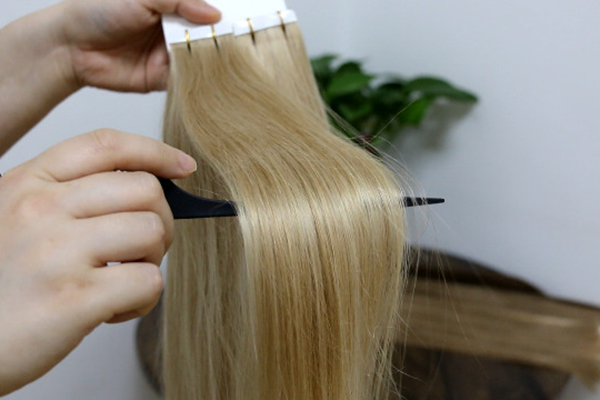Every woman considering clip-in extensions asks this crucial question. The answer isn’t simple – lifespan varies dramatically based on multiple factors that many first-time users overlook.
Quality clip-in extensions typically last 3-12 months with proper care. Remy human hair offers the longest lifespan (6-12 months), while synthetic fibers degrade fastest (6-8 weeks). Frequency of use and maintenance habits are equally important as hair quality.

The lifespan equation breaks down into three critical components:
Hair Quality Spectrum
- Premium Remy human hair (8-12 months)
- Standard human hair (4-6 months)
- Human/synthetic blends (3-4 months)
- 100% synthetic fibers (6-8 weeks)
Usage Frequency Impact
- Daily wear (3-5 month lifespan)
- Weekly wear (6-8 months)
- Special occasions only (10-12 months)
Maintenance Requirements
- Washing technique
- Heat styling limits
- Storage methods
- Installation care
What Are the Disadvantages of Clip-In Hair Extensions?
While convenient, clip-ins present unique challenges that directly impact their usable lifespan. Understanding these drawbacks helps develop proper care strategies.
The temporary nature of clip-ins means they require more frequent replacement than permanent extensions. Daily removal and reinstallation causes cumulative damage that synthetic fibers withstand poorly compared to human hair.

The Science Behind Extension Deterioration
All clip-in extensions degrade through three primary mechanisms:
Mechanical Stress
- Clip tension weakens hair shafts
- Brushing friction damages cuticles
- Daily installation/removal cycles
Chemical Breakdown
- Styling product buildup
- Oxidation from air exposure
- PH imbalance from improper washing
Environmental Factors
- UV radiation damage
- Humidity-induced swelling
- Temperature extremes
Comparative Durability Table
| Extension Type | Average Lifespan | Failure Mode |
|---|---|---|
| Remy Human Hair | 10-12 months | Gradual thinning |
| Standard Human Hair | 6-8 months | Increased shedding |
| Human/Synthetic Blend | 4-5 months | Frizz development |
| 100% Synthetic | 6-8 weeks | Melted ends |
Is It OK to Sleep with Clip-In Extensions?
Sleeping with clip-ins creates multiple problems that accelerate wear. The nighttime environment presents unique hazards many users don’t consider.
Pillow friction during sleep causes up to 10x more damage than daytime wear. The combination of movement, heat, and prolonged pressure creates perfect conditions for rapid extension deterioration.

Detailed Breakdown of Sleep Damage
Friction Effects
- Cuticle erosion from pillow rubbing
- Increased tangling and matting
- Accelerated color fading
Mechanical Stress
- Clip pressure points on scalp
- Twisting forces during movement
- Constant tension on attachment points
Moisture Imbalance
- Scalp oils transferring to extensions
- Night sweat accumulation
- Humidity absorption
Overnight Damage Comparison
| Sleep Position | Damage Level | Primary Concern |
|---|---|---|
| Back Sleeper | Moderate | Clip pressure |
| Side Sleeper | Severe | Friction damage |
| Stomach Sleeper | Extreme | Twisting forces |
Is It OK to Wear Clip-In Hair Extensions Everyday?
Daily use creates cumulative damage that follows predictable patterns. Understanding these wear mechanisms helps extend lifespan.
The 300-cycle rule applies: most clip-ins withstand 300-500 installation cycles before noticeable degradation. Daily use reaches this limit in 6-10 months, while weekly use extends lifespan to 2-3 years.

Daily Wear Physics
Installation Forces
- Clip spring tension fatigue
- Hair shaft bending stress
- Root tension cycles
Environmental Exposure
- Daily UV radiation
- Air pollution buildup
- Temperature fluctuations
Maintenance Challenges
- Product accumulation
- Brushing frequency
- Style changes
Wear Cycle Calculator
| Uses Per Week | Total Lifespan | Failure Point |
|---|---|---|
| 7 (Daily) | 6-8 months | Clip failure |
| 5 (Weekdays) | 9-12 months | Thinning |
| 3 (Alternate) | 14-18 months | Frizz |
| 1 (Weekly) | 2-3 years | Gradual aging |
Can You Shower with Clip-In Extensions?
Water exposure triggers complex physical changes that permanently alter extension structure. The shower environment creates multiple damage vectors.
Hair swells up to 20% when wet, stressing the clip attachment points. This repeated swelling/shrinking cycle causes cumulative structural damage that shortens lifespan by 30-50%.

Hydro-Damage Mechanisms
Cuticle Lifting
- Water penetrates cortex
- Scales remain raised
- Increased friction
Chemical Reactions
- Chlorine bonding
- Mineral deposits
- Shampoo residue
Physical Changes
- Clip corrosion
- Swelling stress
- Weight increase
Water Exposure Effects
| Water Type | Damage Level | Primary Effect |
|---|---|---|
| Distilled | Low | Minimal |
| Tap | Moderate | Mineral buildup |
| Chlorinated | Severe | Chemical damage |
| Saltwater | Extreme | Crystal abrasion |
Conclusion
Clip-in extension lifespan depends on complex interactions between material quality, usage patterns, and care practices. Understanding these underlying mechanisms empowers users to maximize their investment while maintaining hair health. With proper knowledge, even daily users can achieve 6-8 months from quality Remy human hair extensions.







